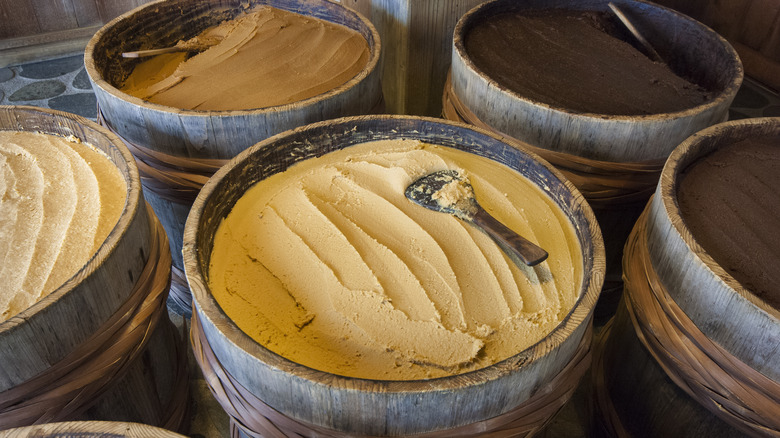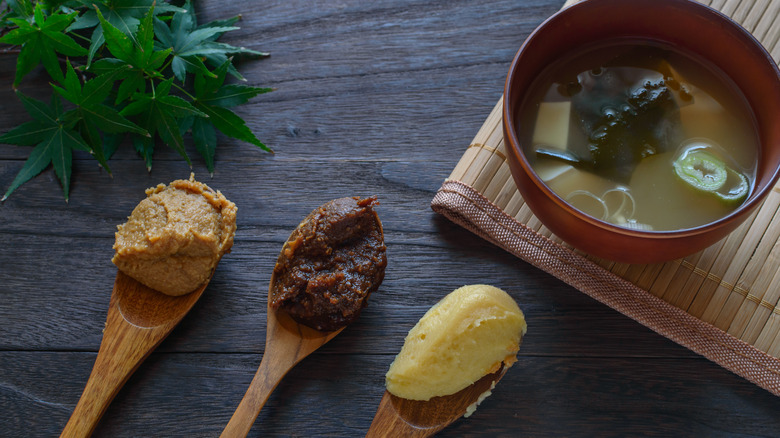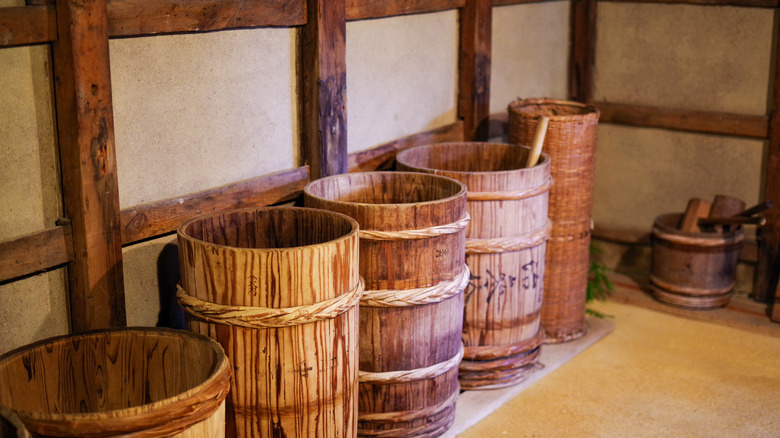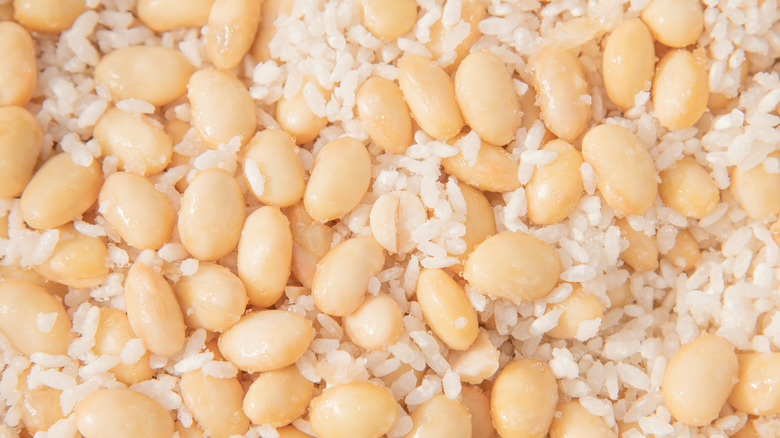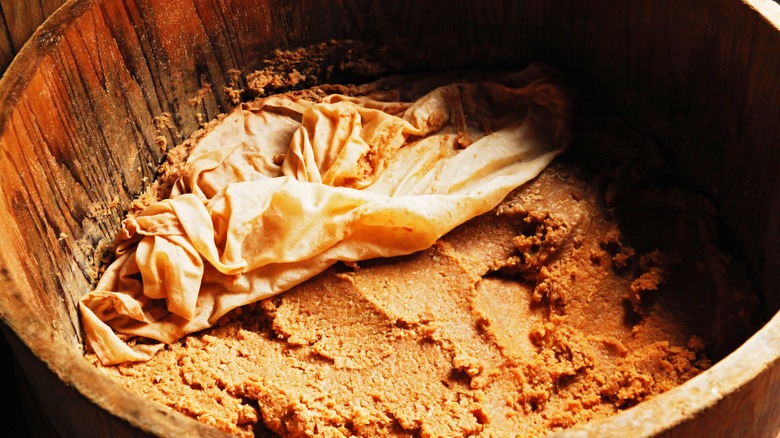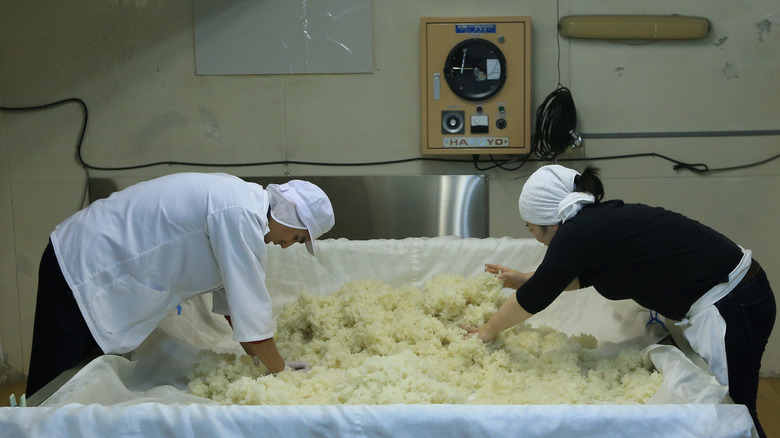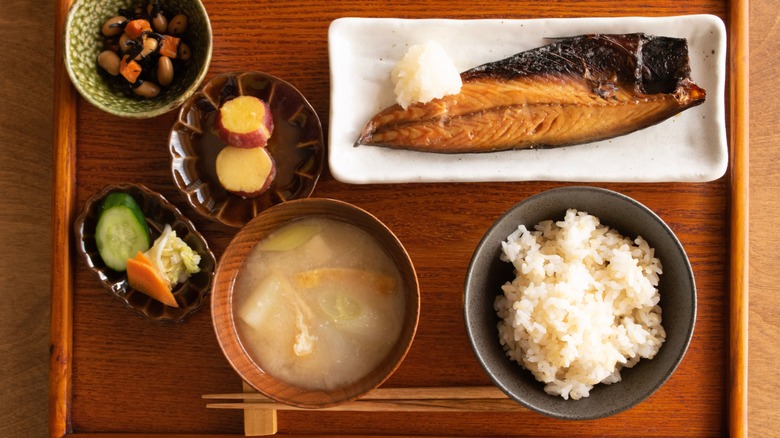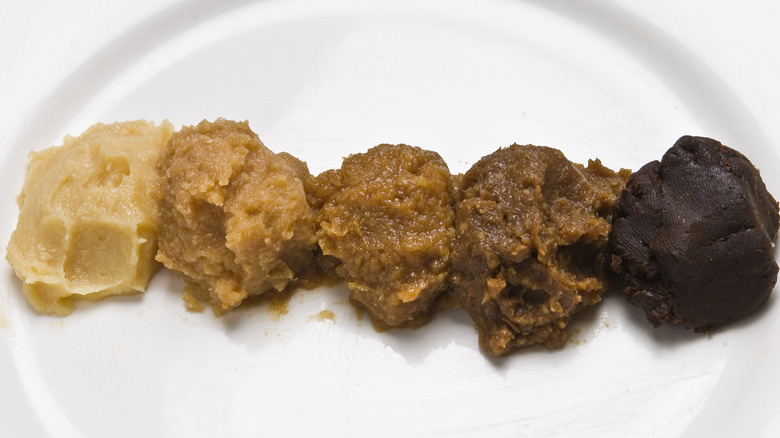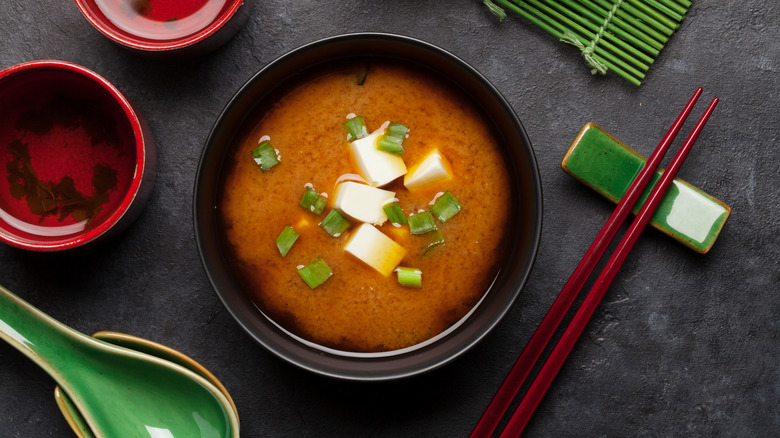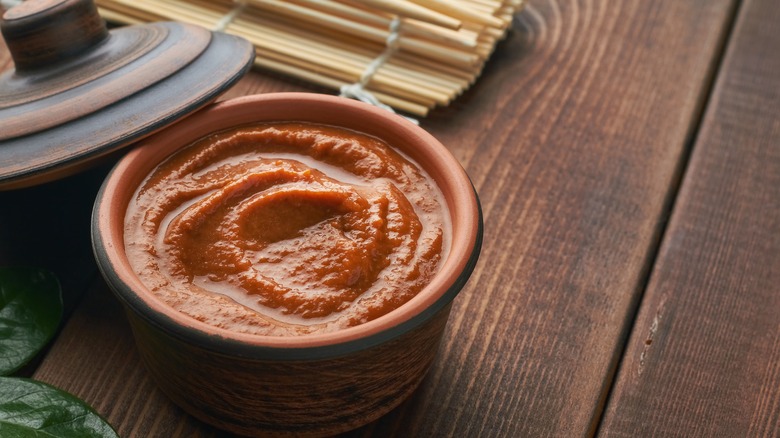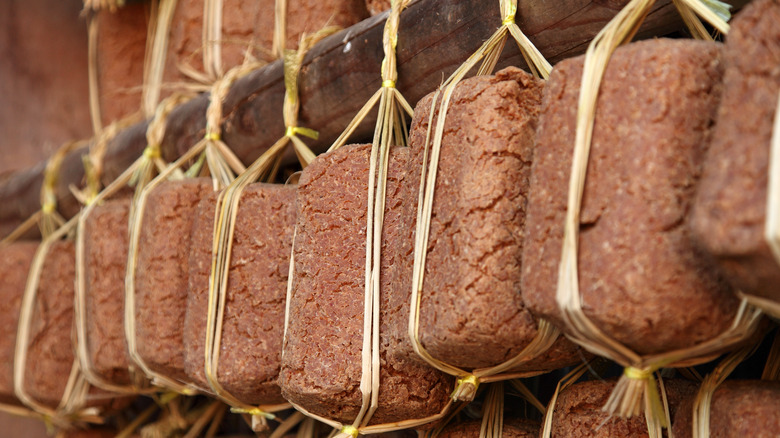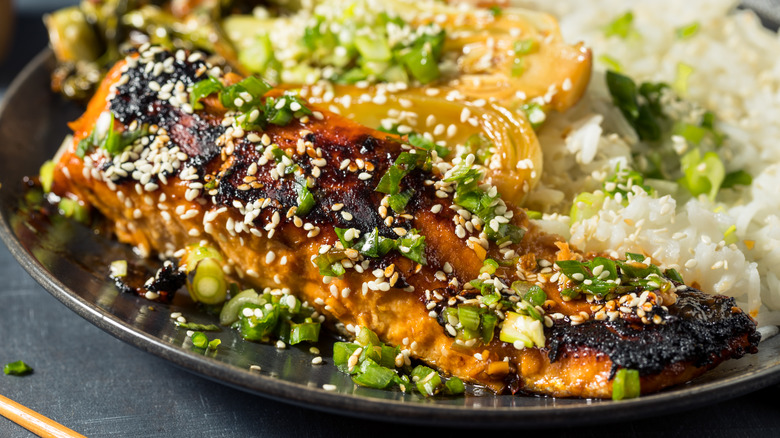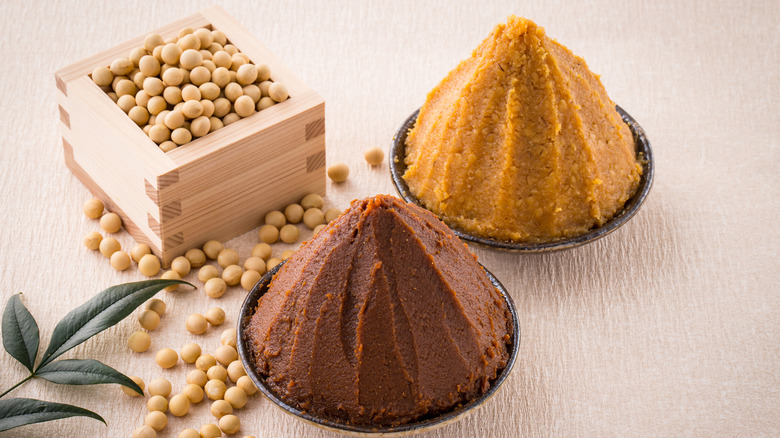Everything You Need To Know About Miso
Miso is a paste of wonders: This special, salty, and savory condiment from Japan is the staple ingredient in the world-famous miso soup. It can also be added to items like salad dressings, stews, glazes, and even desserts.
Miso brings a deep, warming flavor to many dishes and is available in regional variations across Japan. According to Miso-Noodle, miso is rich in many minerals and vitamins, making it not only delicious but also incredibly healthy and good for your body.
So what makes this brown, salty paste so alluring? It is a combination of its uniquely savory flavor that comes from miso's fermentation process and its inherent versatility. There are more types of miso available than you can imagine. This paste is available in a variety for each palate, meaning that everyone can find a version that they like.
There is so much to know about this famous and delicious umami paste. Miso, with its rich history and incredible flavor, has so much to offer.
An introduction to miso
Perhaps you have tried miso and love it, or maybe you still need some convincing. This salty, brown paste may look intimidating, and when you taste it by itself, the flavor can be overwhelmingly strong. The taste is salty, savory, and sometimes a bit sweet: Umami is the best way to describe miso.
So what gives this paste such an umami taste? The best part of miso is that it is fermented. More specifically, it consists of fermented soybeans and grains that have been mixed with a lot of salt (via Just One Cookbook). This large amount of salt is part of what gives miso its distinct taste, and it is also the reason it's important to dilute your miso before eating it.
If you have only ever had miso eaten straight off of a spoon, then it most likely was not your cup of tea. However, miso, when mixed into a soup, salad dressing, or glaze, brings an unimaginable level of umami to your dishes that will make you fall in love.
Miso is Japanese
So where did this salty paste originate? Miso, as we know it today, is from Japan, but the story doesn't stop there. The history of miso can be traced all the way back to ancient China, where it was highly valued as a luxury food item.
Miso was then brought to Japan by Buddhist monks during the Kamakura period, which spanned A.D. 1185-1333 (via World History). The monks would thinly grind the paste in their suribachi mortars and mix it with water, creating the simple yet elegant miso soup.
Miso soup, and miso in general, became a staple for the Japanese elite. Over time, miso came to be enjoyed by the whole population. Today, it can be found in almost all homes across Japan.
In the past, miso was an important source of protein and nutrients, thanks to its fermented nature and the protein from soybeans, according to Shun-Gate. Today, miso is used mostly as a condiment and can be found in many varieties, with specific regions of Japan specializing in their own prized versions.
A brief history of miso
As we just learned, the origins of miso can be traced back to ancient China (via Marukome). But there is more to learn if we look back even further. Just One Cookbook goes over some potential theories regarding how miso was first created. One theory states that the first miso varieties were made by pounding meat and fish with salt and a bacteria culture called koji. We will explain more about the wonders of koji in a moment.
This paste was then left to ferment as a way to preserve perishable goods like meat and fish. A similar paste, called Shi Kuki, was made from pounded soybeans, and it is believed that this was the beginning of miso.
Regardless of the original origins of miso, the paste quickly became uniquely Japanese. The first written account of miso is from the Heian period, which ranged from A.D. 794 to A.D. 1185. During this time, miso was still reserved for the wealthy and middle class, with some royals receiving their salaries in miso and mochigome, which is a variety of sticky rice. It was not until the Edo period, from A.D.1603 to A.D.1868, that miso began to be produced industrially for the masses, as per the Umami Information Center.
Miso is not always made from soybeans
In the past, miso was made from soybeans. According to Marukome, today, around 80 percent of the miso made in Japan today is made mostly from rice mixed in with some soybeans and koji. While much of the miso manufactured in Japan is made industrially, it is also still common for people to make their own miso at home, which results in even more specialized versions of this wonderful paste.
Rice miso, also known as kome miso, is just one out of an almost endless arrays of miso. The flavor, color, and potency of miso can vary depending on the ratio of grain to soybean to salt (via Misotasty).
In fact, Abokichi claims that there may be over two thousand types of miso in Japan, and while many of those are made from rice, they can also be made from other grains like barley or even from other types of beans.
The ingredients of miso change the flavor drastically. As with any fermented product, the flavor of miso will also change depending on the environment it is in and the bacteria in the air. Therefore, while most of the miso in Japan is made with rice, that does not mean it will taste the same or even similar. There are so many factors to take into consideration when it comes to the processing and consumption of miso, which is exactly why each kind of miso has its own unique taste.
Miso is made through fermentation
This ancient paste is made from fermenting grains (usually rice), soybeans, salt, and koji (via Journal of Food Science). The combination of all of these ingredients, mushed together and left to ferment over time, produces the salty and savory flavor that is iconic to miso.
Making miso is actually a two-step process. The first step entails combining rice with a bacteria culture called koji. This is left to ferment for a couple of days until it is ready to be added to the soybean mixture. Before the koji is added, the soybeans and grains are cooked and strained so that they are easier to mush and more susceptible to fermentation.
The grains, koji, and salt are then all mashed together into a paste that can be very smooth or more roughly ground, depending on preference. This paste is then left to ferment in a warm location for up to two years. Industrial miso is fermented in huge barrels in temperature-controlled rooms, while smaller at-home batches may just sit on a kitchen counter while they age (via Miyajima).
An introduction to koji
We keep mentioning koji, so it makes sense that you are wondering what it is by now. Aspergillus oryzae (the scientific name for koji) is a naturally found bacteria culture that has always been present in Japan, which explains why it is commonly found in so many Japanese foods (via Clearspring).
Koji is not actually something you eat directly, rather it flavors many of the umami things that we love, like miso. In order to be added to foods or dishes, cooked rice or soybeans must first be inoculated by koji bacteria and left for a couple of days while the koji takes over. The koji feeds off of the carbohydrates and proteins in the rice and soybeans, creating an amino acid called glutamate.
If glutamate sounds familiar, then maybe it is because you have heard of glutamate in the context of MSG or monosodium glutamate. Like MSG, plain glutamate is incredibly umami and gives koji its signature flavor. The inoculated koji substance can then be mixed into a variety of pastes or liquids to make miso, sake, soy sauce, and more.
Miso is very culturally important
Since its nascence, miso has been a prized item in Japan that was once enjoyed only by the elite (via Marukome). Today, a cultural staple for Japanese people. Miso can be used in marinades for fish or toppings for mochi, but it is most commonly consumed in soup form.
Miso soup is iconic. This soup consists of a slightly milky broth with some green onion or seaweed floating around. It's a national treasure of Japan, This warming, savory, and salty soup is rejuvenating and incredibly comforting, especially for those who grew up eating it almost every day.
It is also an essential component of ichiju-sansai, which is the Japanese term for a balanced meal (via Kokoro). Ichiju-sansai typically consists of rice, miso soup, and a side dish that come together in an elegant and simple meal that serves as the base for many Japanese meals across the country. For Japanese people, miso soup is also a way to celebrate what their region has to offer, with soup ingredients ranging from mussels, to eggplant to wakame.
There are many types of miso
There are countless varieties of miso, especially when you consider the many at-home miso makers who curate their miso specifically to their liking. That being said, there are some general types of miso that are fascinating to compare.
One of the most common types of miso available is shiro miso. This miso is made from rice and left to ferment for about three to four weeks, and it has a mild flavor and slightly sweet taste that is derived from the starch in the rice.
Aka miso or red miso is another type of miso that is widely available. This miso is also often made from rice, but it can also be made from soybeans or barley. Aka miso is aged for up to two years and also contains a higher percentage of salt than shiro miso, making it more pungent, sour, and almost spicy. Other types of miso include mugi miso (barley miso), mame miso (soybean miso), and awase miso, which is made by mixing different types of miso (via Hungry Huy).
However, this is just the tip of the miso iceberg when it comes to different miso varieties. To complicate things further, each area of Japan has a miso that is special to the specific region. Perhaps mame miso is ideal for winter stews, while shiro miso is best to marinate mackerel, but at the end of the day, it is up to you to decide what you prefer most.
Miso is more than just salty
Since there are so many different types of miso, it is hard to pinpoint exactly what miso tastes like because the flavor can change so drastically from variety to variety. Nonetheless, there are some characteristics that all miso varieties share.
For starters, because all miso is made with koji, all varieties have some element of umami which comes from the glutamate that the koji produces (via Clearspring). This umami comes through even more when the miso is mixed with other condiments such as sake, sugar, or soy sauce because the other flavors and tastes combine to make deeply complex flavor profiles.
Eat Delights explains that lighter misos tend to be sweeter, less salty, and milder in flavor. On the other hand, darker misos often have a richer flavor and can be much saltier. This is due to the addition of salt and the lengthy fermentation period, which allows the miso flavor to deepen.
There are several variations of traditional miso
As we know, miso is traditionally available in many varieties, but thanks to its inherent versatility, many chefs and home cooks are experimenting with miso and koji to create unique blends and variations. For example, South River Miso Company makes small-batch golden millet miso which is both organic and gluten-free and brings its own unique flavor to dishes.
Chickpea miso is another variety of miso that is becoming more popular among home cooks (via Full of Plants). This miso is made in the same way as traditional miso as it uses inoculated rice and cooked chickpeas to create a salty paste that is then left to ferment for about six months.
Pea miso is another example of miso innovation that has a sweeter pea-like flavor when it is finished fermenting, according to the National Library of Medicine. All of these miso varieties are indicative of the endless potential of miso. It can be made out of seemingly any legume or grain, and with each new variation, more flavors are unlocked.
Korean and Chinese miso look-alikes
It is believed that the inspiration for modern-day miso comes from ancient China, so it should be no surprise that China and other surrounding countries have very similar condiments (via Marukome). In China, the closest Chinese relative to miso is probably dòubàn jiàng, which is also known as sweet bean paste (via the Woks of Life).
As the name suggests, this paste is sweet, which differentiates it from miso and its spicy cousin, là dòubàn jiàng. Another Chinese condiment that resembles miso is huángdòu jiàng, which, according to The Plant-Based Wok, has a milder flavor and whole pieces of soybean.
Korea has a similar paste known as doenjang, which is very similar to miso, but it does have some distinctions. According to Masterclass, doenjang is often made only with soybeans and salt, while miso is mostly made from rice with some soybeans mixed in.
Additionally, doenjang usually has a chunkier consistency and tends to be much saltier than miso. It is also exposed to the air during its fermentation period, while miso is completely covered.
Miso in cooking
Miso can be used to make soup, but it can also be added to a plethora of other delicious dishes. The other good thing is that a tub of miso can last for months and months, and a little bit goes a long way.
This makes miso a delicious and economical way to boost the flavor of many meals. If you are tired of using your miso in miso soup, try making some delicious miso salmon. The miso sauce caramelizes as the fish cooks, resulting in a wonderfully salty, savory, and slightly sweet glaze.
Because miso is inherently so savory and salty, it also serves very well as a broth substitute. If you add just a little bit of miso, you likely cannot taste the distinct miso flavor and its notes of umami.
The next time you are looking to explore the world of miso, try making some miso braised pork belly, and make sure to pay attention to how the miso flavor transforms and deepens as the meat cooks.
Miso in baking
Salty miso and salty food logically make sense, but what about using adding miso to baked goods? If you are a fan of salted desserts, then next time you whip up a batch of banana bread or caramel cake, throw in a teaspoon of miso and see if you like it.
The beauty of adding miso to dishes in small quantities is that you do not necessarily taste the salty and savory elements that miso is famous for in the final dish. Rather, adding miso to a baked item can help deepen the other flavors in the dish and bring a richness that you didn't even know you were missing.
One of the tastiest ways you can add miso to your desserts is by making miso caramel. If you love salted caramel, then this elevated riff will be perfect for you. The miso brings just the right amount of savoriness, balancing the sweetness of the caramel and making it the perfect topping for desserts. Try pairing your miso caramel with some black sesame ice cream or butter mochi for even more texture and flavor contrast, and you can also add a raspberry on top for an added zing.
Miso is healthy
Miso is delicious, cultural, ancient, and versatile. What more could you ask for? Well, luckily, miso is also incredibly good for you, and it is even considered a superfood. It makes a lot of sense that miso used to be eaten as a protein source because, according to the BBC, just one teaspoon of miso contains about 2 grams of protein and nutrients such as iron, zinc, and folate. This makes miso a wonderful addition to your meals and a nutritious one at that.
Miso also boasts many beneficial bacteria thanks to its long fermentation. These bacteria and probiotics can do wonders for your gut health and greatly aid in digestion. Healthline claims that miso also can help combat certain types of cancer and may play a role in strengthening your immune system. These beneficial probiotics make your gut flora flourish, thus making you more resilient to harmful bacteria.
